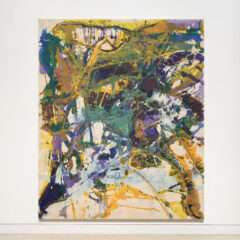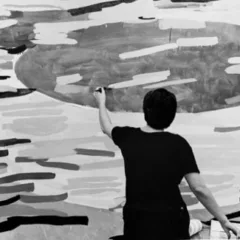Post by Ingrid Pimsner
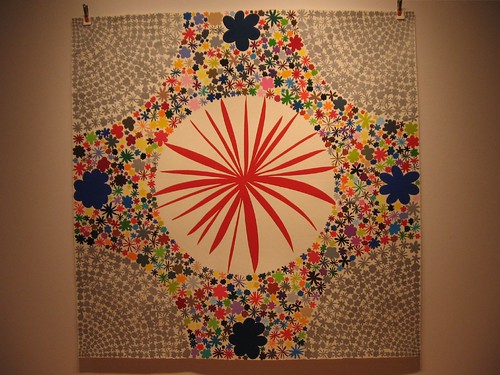
Polly Apfelbaum, Love Park 15, 2007, multi-color woodblock, 79 x 79 inches, photos in this post by libby
Dave Hickey’s “Air Guitar” should be required reading before visiting Locks Gallery this month because if there is any work that captures Hickey’s enthusiasm on the frivolity of art, Polly Apfelbaum’s “Big Love” prints would be it. With the simple child-like imagery of flowers in bright saturated colors, deeply printed into thick handmade paper, her work practically squeals with laughter. The work is jubilant and the forms are strong, like the flower prints the New York Times claims is so hot on the fashion runway this season. And this is fitting because sometimes while looking at the work, one gets the definite sensation of gazing into a loud swirling dress, or maybe peeking through an ever expanding kaleidoscope of someone’s 60’s acid trip, as flowers transform into clouds and stars.
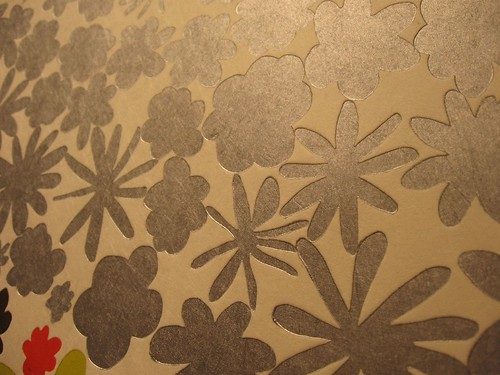
Actually, it is hard to know exactly what one is looking at while enjoying Apfelbaum’s work, but it is precisely this ambiguity that keeps the work captivating even while it exists so simply. Her imagery relates to anything from decorative oriental flower patterns to pop art’s eye catching posters, but refuses to let the viewer neatly pin it down because, like the flowers within them, her prints constantly transform due to some basic playful inconsistencies.
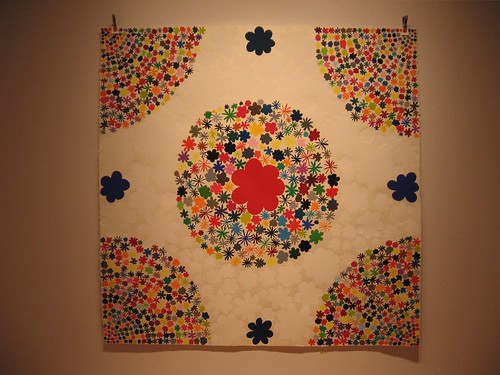
Polly Apfelbaum, Love Park 14, 2007, multi-color woodblock, 79 x 79 inches
The work dances between both worlds; equally comfortable in the crowded commercialized storefront of printmaking and the lonely home of a very fine piece of art. The rich, lovingly hand made paper alludes to oriental craft stressing individuality and fine art value, while the cut out shapes printed on the paper are crude enough that a child could reproduce them with some potato stamps. There is also a fun duality in the way the artist arranged the flowers themselves. At first glance the imagery seems like a pattern, fitted for mass production, but actually, each stamp is separately placed with no mechanical repetition at all. The rough edges of the print’s paper are another twist on the work, since its bright pop art aesthetic would normally feel most at home on cleanly cut poster paper.
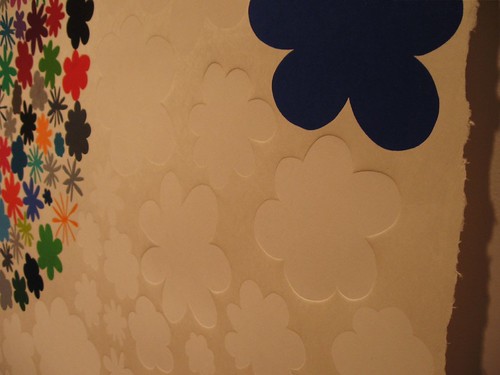
Polly Apfelbaum, Love Park 14, detail
All of these simple contrasts keep the work exciting and fresh, while still retaining a sense of fun abandonment, since it does not seem like the artist felt the need to defend the art from the typical charge of, “but my four year old could make that!” Hickey would be proud of its courageousness and the viewer should be too because until the show comes down on October 27th, they get to reap the rewards.
–Ingrid Pimsner is a student in Colette Copeland’s writing-about-art class at the University of Pennsylvania.



